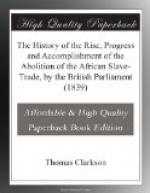All these were present. Granville Sharp, who stands at the head of the list, and who, as the father of the cause in England, was called to the chair, maybe considered as representing the first class of forerunners and coadjutors, as it has been before described. The five next, of whom Samuel Hoare was chosen as the treasurer, were they who had been the committee of the second class, or of the Quakers in England, with the exception of Dr. Knowles, who was then dying, but who, having heard of our meeting, sent a message to us to exhort us to proceed. The third class, or that of the Quakers in America, may be considered as represented by William Dillwyn, by whom they were afterwards joined to us in correspondence. The two who stand next, and in which I am included, may be considered as representing the fourth, most of the members of which we had been the means of raising. Thus, on the 22nd of May, 1787, the representatives of all the four classes, of which I have been giving a history from the year 1516, met together, and were united in that committee, to which I have been all along directing the attention of the reader; a committee, which, labouring afterwards with Mr. Wilberforce as a parliamentary head, did, under Providence, in the space of twenty years, contribute to put an end to a trade, which, measuring its magnitude by its crimes and sufferings, was the greatest practical evil that ever afflicted the human race.
After the formation of the committee[A], notice was sent to Mr. Wilberforce of the event, and a friendship began, which has continued uninterruptedly between them, from that to the present day.
[Footnote A: All the members were of the society of the Quakers, except Mr. Sharp, Sansom, and myself. Joseph Gurney Bevan was present on the day before this meeting. He desired to belong to the society, but to be excused from belonging to the committee.]
CHAPTER XI.
[Sidenote: The preceding history of the different classes of the forerunners and coadjutors, to the time of the formation of the committee, collected into one view by means of a map.—Explanation of this map, and observations upon it.]
As the preceding history of the different classes of the forerunners and coadjutors, to the time of their junction, or to the formation of the committee, as just explained, may be thought interesting by many, I have endeavoured, by means of the annexed map, so to bring it before the reader, that he may comprehend the whole of it at a single view.
The figure beginning at A and reaching down to X represents the first class of forerunners and coadjutors up to the year 1787, as consisting of so many springs or rivulets, which assisted in making and swelling the torrent which swept away the Slave Trade.
The figure from B to C and from C to X represents the second class, or that of the Quakers in England, up to the same time. The stream on the right-hand represents them as a body, and that on the left the six individuals belonging to them, who formed the committee in 1783.




